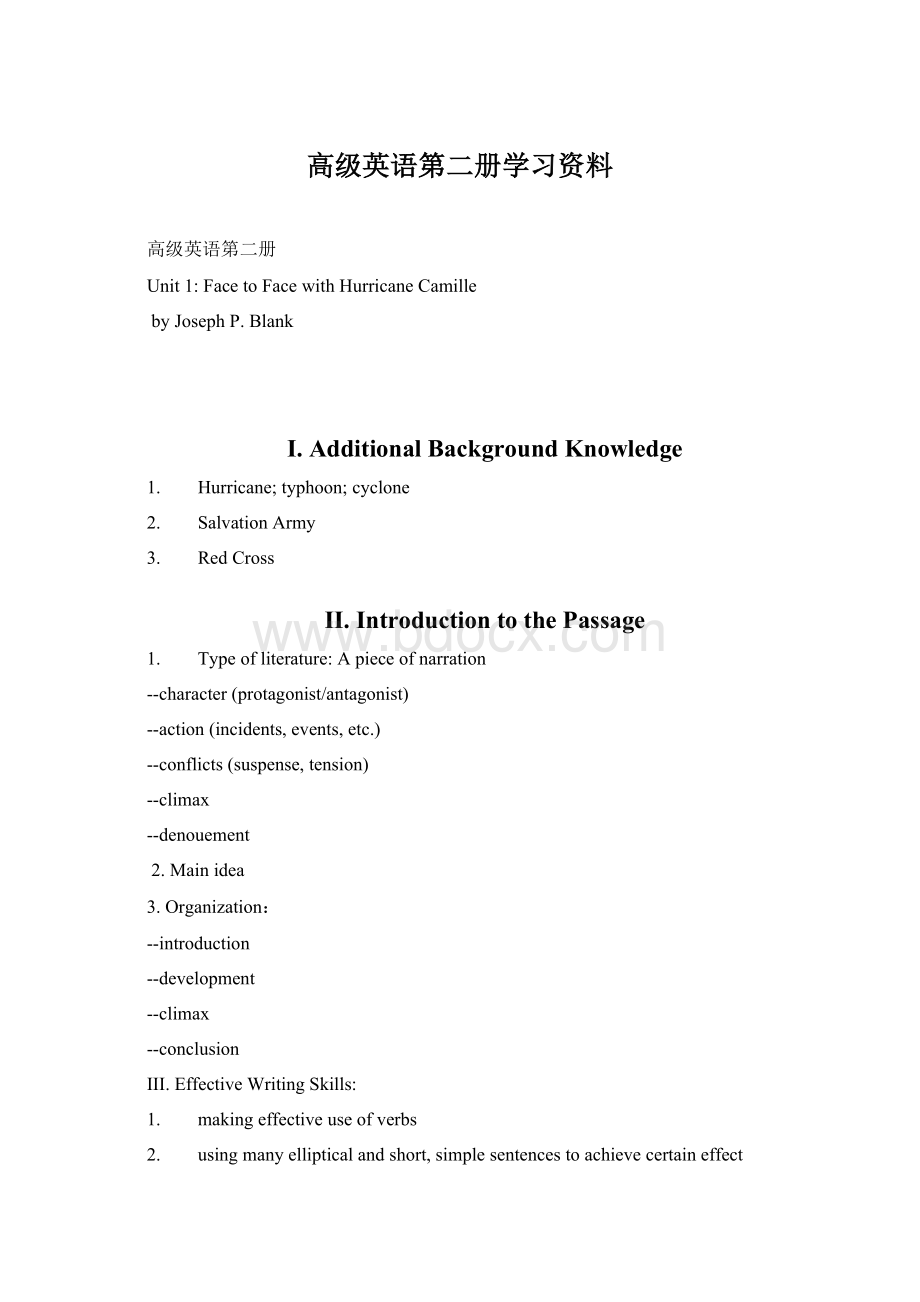高级英语第二册学习资料.docx
《高级英语第二册学习资料.docx》由会员分享,可在线阅读,更多相关《高级英语第二册学习资料.docx(12页珍藏版)》请在冰豆网上搜索。

高级英语第二册学习资料
高级英语第二册
Unit1:
FacetoFacewithHurricaneCamille
byJosephP.Blank
I.AdditionalBackgroundKnowledge
1. Hurricane;typhoon;cyclone
2. SalvationArmy
3. RedCross
II.IntroductiontothePassage
1. Typeofliterature:
Apieceofnarration
--character(protagonist/antagonist)
--action(incidents,events,etc.)
--conflicts(suspense,tension)
--climax
--denouement
2.Mainidea
3.Organization:
--introduction
--development
--climax
--conclusion
III.EffectiveWritingSkills:
1. makingeffectiveuseofverbs
2. usingmanyellipticalandshort,simplesentencestoachievecertaineffect
IV.RhetoricalDevices:
1. transferredepithet
2. personification
3. metaphor
4. simile
V.SpecialDifficulties
Avoidingthefollowingkindsofmistakes:
1. run-onsentences
2. sentencefragments
3. danglingmodifiers
4. illogicalorfaultyparallelism
5. unnecessaryshiftsinpointofview
6. paraphrasingsomesentences
7. identifyingfiguresofspeech
VI.Questions
1. Whatistheorganizationalpatternofthispieceofnarration?
2. Whatdoesthewriterfocuschieflyon---developingcharacter,action(plot),oridea(theme)?
3. Whoistheprotagonistinthestory?
4. Howdoesthewriterbuildupandsustainthesuspenseinthestory?
5. WhydidJohnKoshakfeelacrushingguilt?
Unit2:
MarrakechbyGeorgeOrwell
I.AdditionalBackgroundKnowledge
1. GeorgeOrwell
2. Morocco
3. Marrakech
4. TheJewishpeople
II.IntroductiontothePassage
1. Typeofliterature:
apieceofexposition
2. Thepurposeofapieceofexposition:
--toinformorexplain
3. Waysofdevelopingthethesisofapieceofexposition:
--comparision,contrast,analogy,identification,illustration,analysis,definition,etc.
4. Thecentralthoughtorthesis
III.EffectiveWritingSkills:
1. makingeffectiveuseofspecificverbs
2. usingthemethodsofcontrast,illustration,comparision,etc.
3. cleverchoiceofwordsandscenesandtenses
IV.RhetoricalDevices:
1. rhetoricalquestions
2. repetition
3. metaphor
4. simile
5. ellipticalsentences
V.SpecialDifficulties
1. Makingsentencesmorecompactbypropersubordination,suchassubordinateclauses,appositives,prepositionalorverbalphrases.
2. Discriminatinggroupsofsynonyms:
--wail,cry,weep,sob,whimper,moan
--glisten,glitter,flash,shimmer,sparkle
3. Paraphrasingsomesentences
4. Identifyingfiguresofspeech
VI.Questions
1. Orwellshowsthepovertyofthenativesinatleastfiveways.Identifythem.
2. Couldparagraphs4-7justaswellcomeafter8-15asbefore?
Whyorwhynot?
3. Doesthisessaygivereadersanewinsightintoimperialism?
4. CommentonOrwell’slucidstyleandfineattentiontosignificantdescriptivedetails.
Unit3:
PubTalkandKing’sEnglish
byHenryFairlie
I.AdditionalBackgroundKnowledge
1. pub/pub-friends
2. Dumas/ThreeMusketeers
3. Carlyle
4. CharlesLamb
II.IntroductiontothePassage
1. Typeofliterature:
apieceofexposition
2. Thethesis
3. Whatmakesagoodconversation
4. Seeminglylooseorganization
a. titleb.transitionalparagraphc.digression
5. Highlyinformallanguage
a.abundanceofsimpleidiomaticexpressionscheekedbyjowlwithcopiousliteraryandhistoricalallusions
b.amixedmetaphorinparagraph2
III.EffectiveWritingSkills:
1. deliberatelywritingthisessayinaconversationalstyletosuitthetheme
2. makingeffectiveuseofspecificverbs
IV.RhetoricalDevices:
1. metaphor
2. mixedmetaphor
3. simile
V.SpecialDifficulties
1.Idiomaticexpressions:
--beontherocks
--getuponthewrongsideofthebed
--beonwings
--turnupone’snoseatsth.
--intotheshoesof
2.Allusions
--descendantsofconvicts
--Saxonchurls
--Normanconquerors
--musketeersofDumas
3.Theuseoftransitionaldevices
--transitionalwordsandexpressions
--pronounreference
--repetitionofimportantwords
4.Paraphrasingsomesentences
5.Identifyingfiguresofspeech
VI.Questions
1. What,accordingtotheauthor,makesagoodconversation?
Whatspoilsit?
2. Whatistheauthor’sattitudeofthewritertowards“theKing’sEnglish”?
3. Howdoestheuseofwordsshowclassdistinction?
4. Whatdoesthewritermeanwhenhesays,“theKing’sEnglish,liketheAnglo-FrenchoftheNormans,isaclassrepresentationofreality”?
Unit4:
InauguralAddress
byJohnF.Kennedy
I.AdditionalBackgroundKnowledge
1. JohnFKennedy
2. Hisassasination
3. Inauguration
4. Inauguraladdress
5. Coldwarperiod:
socialistcampvs.capitalistcamp
II.IntroductiontothePassage
1. Typeofliterature:
politicalspeech
2. Objectofapoliticalspeech:
--toexplain
--toconvince
--topersuade
3. Wellorganizedandhighlyrhetorical
4. Biblicalstyle/language
5. Often-quotedpassages
III.EffectiveWritingSkills:
1. Employingsuitablerhetoricaldevicesandwordstocreatethedesiredemotionalimpact
2. clearorderandappropriatetonetothedifferentgroupsheisaddressing
3. EmployingBiblicalstyledeliberately
IV.RhetoricalDevices:
1. metaphor
2. antithesis
3. parallelism
4. repetition
V.SpecialDifficulties
1.Biblicallanguage/quotations/style
2.Usingthefollowingmethodsforforce,vividnessandemotionalappeal:
--Parallelandbalancedstructure
--Repetitionofimportantwords
--Antithesis
3.Paraphrasingsomesentences
4.Identifyingfiguresofspeech
VI.Questions
1. CiteexamplestoshowthatKennedyisveryparticularandcarefulinhischoiceanduseofwords.
2. Istheaddresswellorganized?
Commentontheorderinwhichheaddressedallthedifferentgroupsofnationsandpeople.
3. IsKennedy’sargumentandpersuasionbasedmainlyonfactsandlogicoronanappealtoemotions?
Wouldthistypeofspeechbesuccessfulonalloccasions?
4. Isthetoneandmessagesuitedtothedifferentgroupsheaddresses?
Giveyourreasons.
Unit5:
LoveIsaFallacy
byMaxShulman
I.AdditionalBackgroundKnowledge
1. ThemeaningofLogicalfallacies
2. Logicalfallacies:
--DictoSimpliciter
--HastyGeneralization
--PoisoningtheWell
--AdMisericordiam
II.IntroductiontothePassage
1. Typeofliterature:
apieceofnarrativewriting
--protagonist/antagonists
--climax
--denouement
2. Themaintheme
3. Wellchosentitleandwords
4. Style
--averyfastpacewitharacydialoguefullofAmericancolloquialismandslang
--employingavarietyofwritingtechniquestomakethestoryvivid,dramaticandcolorful
III.EffectiveWritingSkills:
1. Employingcolorfullexicalspectrum,fromtheultralearnedtermstotheinfraclippedvulgarforms
2. Toomuchfigurativelanguageandungrammaticalinversionforspecificpurposes
3. Theusingofshortsentences,ellipticalsentencesanddashestomaintainthespeedofnarration
IV.RhetoricalDevices:
1.metaphor
3. antithesis
4. transferredepithet
4. hyperbole
5. metonymy
6. litotes
7. ellipsis
8. synecdoche
9. inversion
10. simile
11. mixedmetaphor
12. rhetoricalquestions
V.SpecialDifficulties
1. Analyzingthelogicalfallacies
2. Usinginvertedsentencestoachieveemphasis
3.Effectivelyusingmanyfiguresofspeech
4.Understandingcolloquialexpressionsandslang
5.Allusions:
--Frankenstein
--Pygmalion
6.Paraphrasingsomesentences
7.Identifyingfiguresofspeech
VI.Questions
1. Defineandgiveanexampleofeachofthelogicalfallaciesdiscussedinthisessay.
2. Canyoufindanyevidencetosupporttheviewthatthewriterissatirizingabrightbutself-satisfiedyoungman?
3. CommentonthelanguageusedbyPolly.Whateffectdoesherlanguagecreate?
4. WhydoesthewriterrefertoPygmalionandFrankenstein?
Aretheseallusionsaptlychosen?
5. Inwhatsenseistheconclusionironic?
Unit6:
DisappearingThroughtheSkylight
ByOsborneBennetHardisonJr.
I.AdditionalBackgroundKnowledge
1. AbriefintroductiontoO.B.HardisonJr.
2. AbriefintroductiontohisviewsinCultureandTechnologyintheTwentiethCentury
3. Internationalstyle
4. FeaturesofscientificEnglish
II.IntroductiontothePassage
1. Thecentralthemeof“disappearance”
--naturedisappears
--historydisappears
--solidbanksdisappears
2.Thefourimportantideasputforward
--disappearance
--theuniversalizingtendencyofscienceandtechnology
--manasacosmopolitan
--theplayfulnessofscience
3.Clearlyandlogicallyorganized
III.TheStylisticFeatures
1. FeaturesofscientificEnglish
--technicaltermssuchasthermodynamics,genetics,geneticmutation,etc.
--shortsentencesandpresenttenseusedtoexpressauniversalstatement
2.Usingfigurativelanguagefreelytomakeideasmorevividandforceful
IV.RhetoricalDevices:
1.metaphor
2. analogies
3. repetition
4. balancedstructures
5. ellipsis
6. rhetoricalquestions
V.SpecialDifficulties
1. Sometechnicalterms
2. Understandingthemetaphoricalphrase“DisappearingThroughtheSkylight”
3. Theuseoftopicsentences
4. Theuseofpres